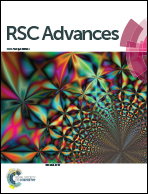Total synthesis and stereochemical assignment of cryptolatifolione†
Abstract
An enantioselective total synthesis of cryptolatifolione and its C-8 epimer is presented in a protecting-group-free fashion. The synthesis relied on the use of a catalytic double Krische allylation, catalytic olefin metathesis and a C–H oxidation. Comparison of spectroscopic data of the synthetic isomers and natural product made possible the unambiguous elucidation of the absolute configuration of cryptolatifolione.


 Please wait while we load your content...
Please wait while we load your content...